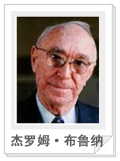杰罗姆·布鲁纳(JEROME SEYMOUR BRUNER)
——心理学家、教育家(1915~ ) |
|
杰罗姆·布鲁纳——1915年10月1日出生在美国纽约。1937年在杜克大学获文学学土学位,随即在杜克大学注册成为心理学研究生,第二年转学到哈佛大学心理学系,在著名实验心理学家拉什利(K.S.Lashleg)指导下,于1941年获博士学位。这时他的主要兴趣是动物和人类的知觉过程心理学。 |
第二次世界大战期间应召服兵役,先后在美国战争情报署和同盟远征军最高统帅部心理战部门工作,主要是研究公众的态度和纳粹德国的宣传技术。1945年返回哈佛大学任心理学讲师,1948年任副教授,1952年任教授。1960年,他与米勒(G.Miller)一起创办了"哈佛认知研究中心",1961年起任该中心主任直至1972年。1972年至1980年在英国牛津大学任实验心理学瓦茨 (Walts) 教席。1980年返回美国任纽约大学的人文学科新学院院长之职。
布鲁纳在众多领域进行了富有成效的研究,是一位在西方心理学界和教育界都享有声誉的学者,他在1959年任美国科学院科学教育委员会主席,主持了著名的伍兹霍尔中小学课程改革会议;1960年任总统教育顾问;1952年当选为社会心理学研究会理事长;1965年当选为美国心理学会主席。1962年获美国心理学会颁发的杰出科学贡献奖。布鲁纳论著甚丰,主要代表著作有:《思维之研究(A Study of Think )》(1956,与人合作)、《教育过程(The Process of Education)》(1960)、《论认识(on Knowing)》(1964)、《教学理论探讨(Toward a Theory of Instruction)》(1966)、《认知生长之研究(Studies in Cognitive Growth)》(1966,与人合作)、《教育的适合性(The Relevance of Education)》(1971)、《超越所给的信息(Beyond the Information Given)》(1973)、《儿童的谈话:学会使用语言(Child's Talk: Learning to Use Language)》(1983)、《心的探索(In Search of Mind)》(1984)
|
JEROME SEYMOUR BRUNER ( 1915~ current) |
Jerome Bruner was born on October 1, 1915 in New York City. Bruner received his A.B. from Duke University in 1937 and his Ph.D. from Harvard in 1941. He was formally a professor of Psychology at Harvard University (1952-1972) and Oxford (1972-1980). Currently he is at the the New York University of Law. In 1960, he wrote The Process of Education, which emphasizes curriculum innovation grounded in theories of cognitive development.
Bruner asserts that learning is an active process in which students construct new ideas or concepts based on their current knowledge.
Jerome Bruner, a developmental psychologist, formulated a theory of cognitive growth that postulates: "The development of human intellectual functioning from infancy to such perfection as it may reach is shaped by a series of technological advances in the use of mind (1964)." He believed that as children develop, their actions are constrained less by immediate stimuli. Cognitive process (thoughts, beliefs) mediate the relationship between stimulus and response so that learners might maintain the same response in a changing environment or perform different responses in the same environment, depending on what they consider adaptive. In his more recent work, Bruner (1986, 1990) has expanded his theoretical framework to encompass the social and cultural aspects of learning. His constructivist theory is a general framework for instruction based upon the study of cognition. Much of the theory is linked to child development research (especially Piaget ).
Bruner's Main Concepts
A major theme in the theoretical framework of Bruner is that learning is an active process in which learners construct new ideas or concepts based upon their current/past knowledge.
Representation
There are three ways to represent knowledge, which emerge in a developmental sequence:
Enactive representation- At the earliest ages, children represent objects in terms of their immediate sensation of them. It represented in the muscles and involves motor responses, or ways to manipulate the environment (i.e. riding a bicycle and tying a knot).
Iconic representation- This involves the use of mental images that stand for certain objects or evens. Iconic representation allows one to recognize objects when they are changed in minor ways (e.g. mountains with and without snow at the top).
Symbolic representation-This uses symbol system to encode knowledge. Prominent symbol systems are language and mathematical notation.
Spiral curriculum
Bruner emphasized teaching as a means of enhancing cognitive development. Students will not understand the concept the way teachers plan to teach it. Instruction needs to be watched to children's cognitive capabilities. The task of the instructor is to translate information to be learned into a format appropriate to the learner's current state of understanding. Curriculum should be organized in a spiral manner so that the student continually builds upon what they have already learned. Teachers must revisit the curriculum by teaching the same content in different ways depending on students' developmental levels. Before children can comprehend abstract mathematical operations represented enactively (with blocks) and iconically (in pictures).
Here are the principles of instruction stated by Bruner:
Instruction must be concerned with the experiences and contexts that make the student willing and able to learn (readiness).
Instruction must be structured so that it can be easily grasped by the student (spiral organization).
Instruction should be designed to facilitate extrapolation and or fill in the gaps (going beyond the information given).
Discovering learning
Discovery learning refers to obtaining knowledge for oneself. Teacher arranges activities that students search, manipulate, explore, and investigate. Students learn new knowledge relevant to the domain and such general problem-solving skills as formulating rules, testing and gathering information. Most discoveries are not lucky occurrences. Students require background preparation (the well-prepared mind required declarative, procedural, and conditional knowledge). Once students possess prerequisite knowledge, careful structuring of material allows them to discover important principle.
Application
The teacher encourages students to discover principles by themselves. The teacher and students should actively discuss issues and concepts (i.e., socratic learning). The teacher must translate information to be learned into a form appropriate to the learner's current state of understanding.
Bruner (1966) states that a theory of instruction should address four major aspects:
predisposition towards learning, the ways in which a body of knowledge can be structured so that it can be most readily grasped by the learner, the most effective sequences in which to present material, the nature and pacing of rewards and punishments.
Good methods for structuring knowledge should result in simplifying, generating new propositions, and increasing the manipulation of information.
Not all educators or theorists are as enthusiastic as Bruner about the use of discovery methods in school. Reception learning (Ausubel), a relatively mild controversy pitting discovery teaching, has been going on in educational circles for several decades. |
